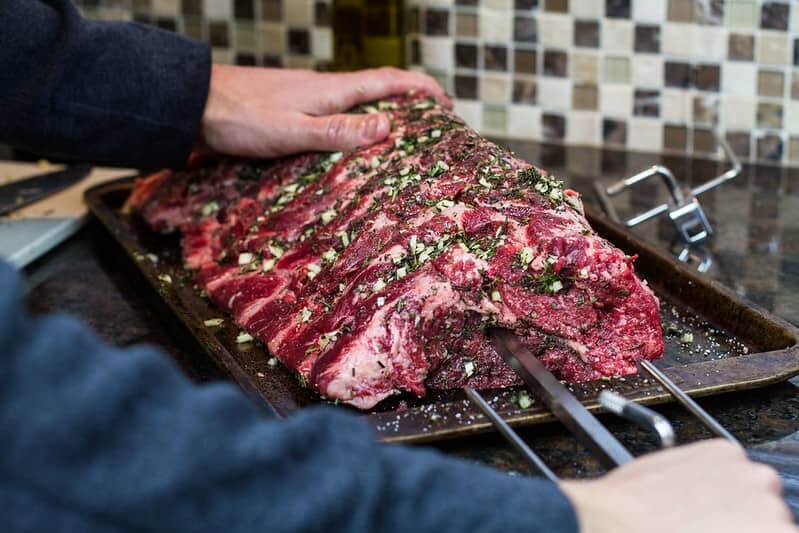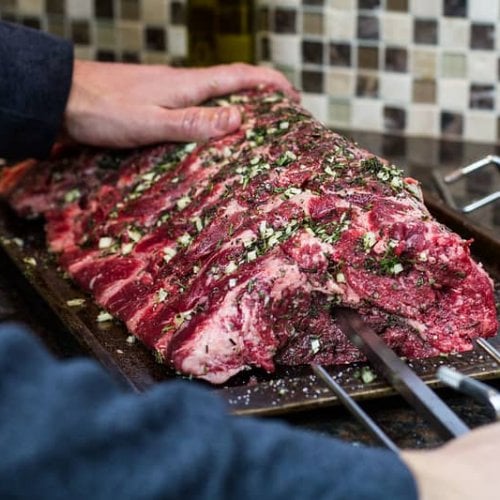
Handling a whole ribeye roast shouldn’t intimidate you. Similar to a prime rib roast but minus the ribs, this cut was first popularized by The Delmonico Restaurant of New York. Get slice after slice of beautifully juicy and soft beef by following the slow-cooking method with your ribeye roast.
What is Slow Cooking?
Slow cooking simply means turning down the heat so that it takes longer to cook a specific dish. While some methods, like frying, rely on speed and high heat for a crispy texture, most meats benefit from slow cooking in general. It helps melt the fat so it spreads through the muscle fiber for a juicier, softer, and tastier dish. Muscle fibers gently relax during this cooking method, making it easier to cut larger sections of meat like the ribeye.
What are the different methods of slow cooking?
Simmering or braising meats in liquid is a traditional way of slow cooking, but it’s far from the only option. While methods like sous vide are flashy and popular, you can easily slow cook with home equipment you already have on hand, such as your oven. Oven slow cooking is the easiest method to start with, especially for meat like whole roasts, since modern ovens already control temperature and time for you.
Slow Cooking Ribeye Roast Tips
Slow-cooking ribeye roast starts with proper preparation of the meat. While the butcher will do most of the work for you, you may want to trim down the fat cap for easier slicing. Leave at least a thin layer of fat over the top to naturally baste the roast as it cooks. Use a real roasting pan rather than a baking sheet or glass casserole dish to handle the juices that will accumulate while providing better browning. Consider saving the juices for au jus or gravy after the roast gets a chance to rest. Make sure your oven is hitting the desired temperature with an accurate thermometer since being even 10 degrees off can lead to slow cooking issues. If you only have a range top to use, consider a Tomahawk ribeye steak or Cowboy ribeye for a similar flavor.
How to Season and Prepare the Ribeye Roast
Ribeye roasts generally need less preparation and trimming than prime rib. However, you still may want to trim up the fat a little based on personal preference. Injecting the meat with butter or flavoring is generally not needed since this is a soft and marbled cut of beef rather than a lean one. Applying a dry or butter-based rub can add a lot of flavor. Popular spice combinations for rubs include:
- Green herbs commonly used as Italian seasonings, including marjoram, sage, thyme, rosemary, basil, and oregano
- Double pepper power from freshly cracked black pepper and smoked paprika or freshly ground chili powder
- Lemon and black pepper, which works best when you use crystallized lemon juice powder
- Mediterranean flavors inspired by gyros, combining cumin, oregano, sage, and plenty of garlic.
What To Serve With Ribeye Roast
Mashed potatoes, roasted potatoes, or even boiled potatoes covered in butter are all classic starchy side dishes to enjoy alongside a carved roast. The slow-cooked ribeye roast pairs particularly well with creamy pasta dishes as well, such as cacio e pepe. For contrast to the rich meat, a side salad with sharp flavors of mustard greens and arugula can liven up the palate. Don’t forget the roasted brussel sprouts or long-cooked kabocha squash, both of which can go in the oven along with the roast.
Sauces for Ribeye Roast
This is far from a dry cut of meat, but adding a flavorful sauce can dress up the ribeye roast if you choose not to rub or marinate it. Seasoned roasts still benefit from a basic au jus since it takes little effort to whip up on the side.
Horseradish Sauce
Skip the pre-made horseradish sauce and pick up just pure ground horseradish in a jar instead.
Homemade Horseradish Sauce Recipe:
Mix:
- 2 tablespoons of horseradish
- ½ cup of sour cream
- 2 tablespoons of mayonnaise
- 1 teaspoon of apple cider vinegar
*Consider adding ½ teaspoon of dijon mustard and 1/8 teaspoon of black pepper for extra depth of flavor.
Garlic Butter Sauce
Tips:
- Grind one to two cloves of garlic per stick of butter for a pure garlic butter sauce that isn’t too overpowering.
- Adding herbs like dill, sage, basil, and oregano spice it up
- while 1/8th of a cup of cream per stick of butter can thicken the sauce slightly for more of a drizzle.
Au Jus Sauce
Au Jus is one of the simplest sauces to make because it’s simply a reduced and concentrated form of the ribeye roast’s natural juices. Slow cooking is the best method for producing juice for Au Jus, but you’ll need to use a roasting pan to ensure the juices don’t all cook off over time.
Homemade Au Jus Sauce Recipe:
Ingredients:
- ¼ cup red wine of choice
- ½ stick of butter
- 2 tbsp all-purpose flour
Instructions:
- Melt half a stick of butter in a pan and stir in two tablespoons of all-purpose flour.
- Cook that paste until it turns just a light golden brown color,
- then mix in ¼ cup of red wine.
- Let this mixture cook until the alcohol smell fades.
- Add in 2 cups of the drippings and liquid from the roast, or whatever drippings are available plus beef broth to equal the amount.
- Bring to a boil until it thickens slightly
- season it with salt and pepper to taste.
Chimichurri Sauce
A classic green sauce popular in Argentinian barbecuing culture, this mixture has a strong punch of both garlic and vinegar mixed with the spice of fresh green herbs.
- Chop up 1 cup of fresh parsley,
- 2 tablespoons of fresh oregano
- 3 to 4 garlic cloves.
*A food processor speeds up this step.
Mix the herbs and garlic together with:
- 1/3 cup olive oil
- 2 tablespoons of any kind of wine or cider vinegar
- ½ teaspoon of salt
- 1/8 teaspoon black pepper
- ¼ teaspoon of red pepper flakes
- Let this sauce sit for a few hours at least or overnight so it can all blend before it’s used.
How to Slow Cook a Ribeye Roast in the Oven
If you’ve got an oven that can fit the roast inside it, reach 425 for a few minutes, and hold the temperature at 325, you can slow-cook ribeye roast at home.
Ingredients:
- 1 ribeye roast between 4 and 6 lbs
- 5 tablespoons of butter, melted for basting (can substitute olive oil)
- 2 tablespoons of kosher salt (omit if using a rub with salt)
- Any desired seasonings, rubs, or basting products.
Instructions:
- Preheat the oven to 425 degrees Fahrenheit.
- Place roast into a shallow metal or glass roasting pan. Keep the fat cap up so the fat can baste the meat as it cooks. Apply any seasonings or rubs desired.
- Brush the roast with a layer of melted butter if it doesn’t already have a fat-based rub applied.
- Place in the oven and let it roast for only 15 minutes at the higher temperature. Use a medium rack setting that doesn’t keep the meat too close to an upper or lower heating element.
- Reduce the oven’s temperature to 325 degrees Fahrenheit. Set a timer for two hours.
- After two hours, check the roast’s internal temperature with a meat thermometer. For a medium rare ribeye roast, aim for 115 degrees F. Medium ribeye roast will need to reach 125 degrees while it’s still in the oven. Well-done roasts begin at 130 degrees, but aim to remove the roast before it hits 140 degrees internally.
- Cover the roast with a tent of aluminum foil so it doesn’t dry out and let it rest for 10 to 20 minutes before cutting, with medium roasts needing longer rest due to the softness of the meat.
Notes
If the roast still seems a little too soft or jiggly to cut, try returning the roast to the oven set at 325 degrees F with the aluminum foil in place for another 10 minutes. This should help firm up the meat without cooking it much beyond your preferred texture.
Slow Cooked Ribeye Roast in the Oven – Nutritional Facts
Per Serving (based on 8 servings, based on a 2,000-calorie daily diet)
| Nutrient | Amount (% Daily Value (DV)) |
|---|---|
| Calories | 570 (29%) |
| Total Fat | 44g (56%) |
| Saturated Fat | 17g (85%) |
| Trans Fat | 2g |
| Cholesterol | 135mg (45%) |
| Sodium | 820mg (36%) |
| Total Carbohydrate | 0g (0%) |
| Dietary Fiber | 0g (0%) |
| Total Sugars | 0g |
| Added Sugars | 0g (0%) |
| Protein | 41g (82%) |
| Vitamin D | 0.3mcg (2%) |
| Calcium | 20mg (2%) |
| Iron | 3.9mg (22%) |
| Potassium | 620mg (13%) |
How to Cut a Ribeye Roast
Cutting a ribeye roast takes a little more patience when it has been slow-cooked because it’s usually soft and juicy. Use a sharp knife and slice straight downward, cutting against the grain and through the fat cap first. Aim for cuts around ¾ to 1 inch thick.
Conclusion
With a slow roast and a good resting time, a ribeye roast should be a breeze to slice and a dream to eat. Find a perfect beef roast for your next holiday meal and you’ll know exactly what to do with it.

Slow Cooked Ribeye Roast in the Oven
Ingredients
- 1 4-6lb ribeye roast
- 5 tbsp butter, melted for basting (can substitute olive oil)
- 2 tbsp kosher salt (omit if using a rub with salt)
- any desired seasonings, rubs, or basting products
Instructions
- Preheat the oven to 425 degrees Fahrenheit
- Place roast into a shallow metal or glass roasting pan. Keep the fat cap up so the fat can baste the meat as it cooks. Apply any seasonings or rubs desired
- Brush the roast with a layer of melted butter if it doesn’t already have a fat-based rub applied
- Place in the oven and let it roast for only 15 minutes at the higher temperature. Use a medium rack setting that doesn’t keep the meat too close to an upper or lower heating element
- Reduce the oven’s temperature to 325 degrees Fahrenheit. Set a timer for two hours
- After two hours, check the roast’s internal temperature with a meat thermometer. For a medium rare ribeye roast, aim for 115 degrees F. Medium ribeye roast will need to reach 125 degrees while it’s still in the oven. Well-done roasts begin at 130 degrees, but aim to remove the roast before it hits 140 degrees internally
- Cover the roast with a tent of aluminum foil so it doesn’t dry out and let it rest for 10 to 20 minutes before cutting, with medium roasts needing longer rest due to the softness of the meat

